 |
🌲 Coniferous TreesDefinition: (aka Conifers) Any of various mostly needle-leaved or scale-leaved, chiefly evergreen, cone-bearing gymnospermous trees. There are some 550 species of conifers, including Pine, Fir, Spruce, Hemlock, Cypress, Juniper, Yew, and Redwood. |
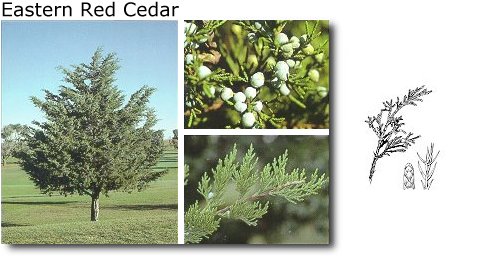
''Eastern Red Cedar''❖ About this Tree:One of the best conifers for wildlife habitatWell adapted to most soils Grows 25' - 60' tall Hardiness: Zone 3 ❖ Identification Tips:Leaves: Two types, usually on the same tree -- scale-like and awl shapedFruit: Blue berrylike cone, ¼" - ⅓" in diameter Twig: 4-sided |
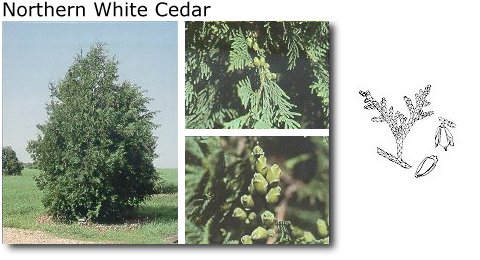
''Northern White Cedar''❖ About this Tree:Foliage, twigs eaten by White-tailed deerFruit eaten by various birds Prefers neutral to alkaline soils, limestone origin Grows 40' - 70' tall Hardiness: Zone 2 ❖ Identification Tips:Leaves: Evergreen; opposite; 1⁄16 to ⅛" long; scalelike; dull yellow-green; foliage sprays fanlikeFruit: Cone; ⅜" long; elliptical; upright from short curved stalk Bark: Light red-brown; thin; fibrous |
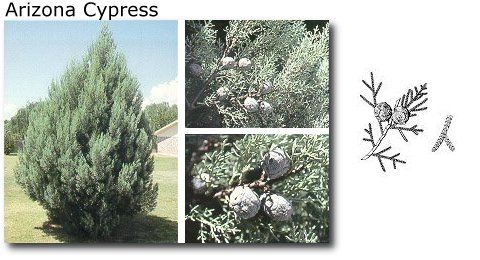
''Arizona Cypress''❖ About this Tree:Used for erosion control, windbreaks, urban landscaping, posts, stakes and corral polesPrefers moist gravelly soils on slopes and benches Grows 40' - 60' tall Hardiness: Zone 6 ❖ Identification Tips:Leaves: Minute blue-green to gray-green; scale-like; sharp pointed; finely toothed on the margins; shunlike odor when bruisedFruit: Dark reddish brown cones about 1" long that remain on the tree for many years, become gray with age Bark: Reddish brown with irregular, narrow, thin, curling scales that peel; on older tree's, bark becomes furrowed |
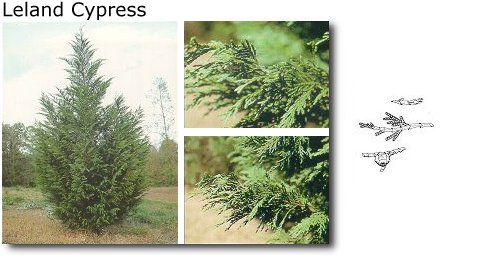
''Leland Cypress''❖ About this Tree:Used as Christmas treesAlso good for hedgerows, windbreaks and landscaping Adapted to a wide range of soil textures Prefers moist, well drained soils Grows 60' - 70' tall Hardiness: Zone 5 ❖ Identification Tips:Leaves: Blue-green to gray-green needles, 1/8 inch long; acute; appressed with the apices of the lateral pairs often freeFruit: Cone, ½" to ¾" in diameter with 8 scales; each scale contains approximately 5 seeds per scale Bark: Reddish-brown and scaly |
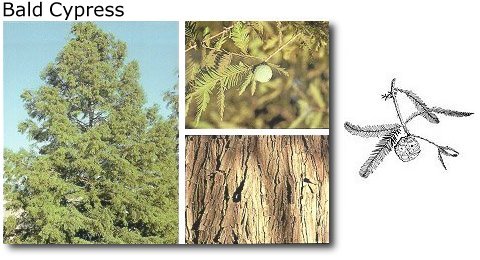
''Bald Cypress''❖ About this Tree:Well adapted to wet sitesCan be planted on dry sites Wood very resistant to decay Develops 'knees' under saturated conditions Grows 60' - 100' tall Hardiness: Zone 4 ❖ Identification Tips:Leaves: Needle-like; delicate; arranged in 2 ranks in a feather-like fashion along small branchlets; branchlets with fine needles fall in the autumnFruit: Globe-shaped, woody cone, 1" in diameter; cones disintegrate at maturity Twig: Reddish-brown; rough, with several short peg-like branches Bark: Dark reddish-brown with long loose shreddy ridges |

''Concolor Fir''❖ About this Tree:Provides winter cover for wildlifePrefers dry to moist soils Grows 75' - 100' tall Hardiness: Zone 3 ❖ Identification Tips:Leaves: Needles; slat; linear; 2-ranked; blue-green; 1½" to 2½" longFruit: Cone; erect; olive brown; cylindrical; 3" - 5" long Twig: Stout; yellow-green with clustered blunt, red-brown resinous buds Bark: Ash, gray-brown color; flattened ridges |
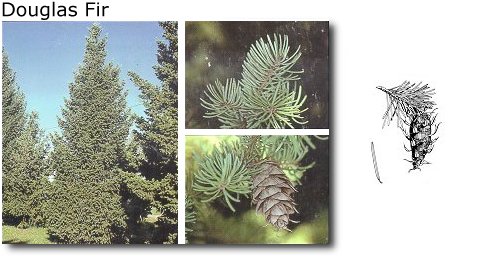
''Douglas Fir''❖ About this Tree:Winter cover for wildlifePrefers well drained, loamy soils Grows 80' - 200' tall Hardiness: Zone 3 ❖ Identification Tips:Leaves: Needles; flexible; flattened; light green-bluegreen; blunt tip; ¾" - 1¼" longFruit: Cone, tan-brown; 2" - 3" long; clustered pairs; 3 points; protruding bracts Twig: Slender; gray-brown; long; sharp-pointed buds Bark: Reddish brown; deep furrows |
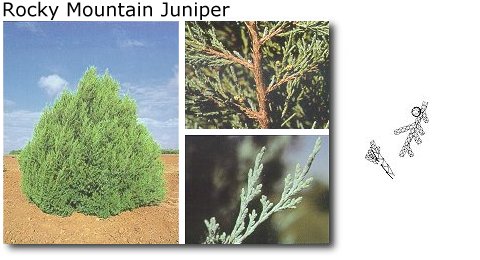
''Rocky Mountain Juniper''❖ About this Tree:Foliage and fruit eaten by mammals and birdsCan grow on dry to moist soils Grows 25' - 50' tall Hardiness: Zone 3 ❖ Identification Tips:Leaves: Small; scale-like; opposite; smooth edges; 1" - 2" longFruit: Small; fleshy; berry-like; .2" - .3" in diameter; bright blue Twig: Slender, 4-sided; becoming rounded with age Bark: Thin; reddish-brown; weathering to grayish |
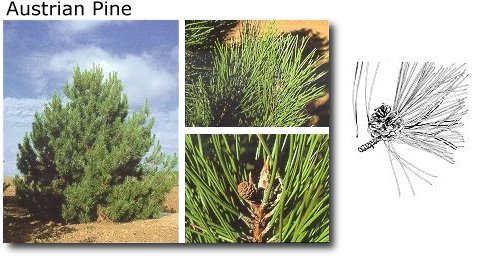
''Austrian Pine''❖ About this Tree:Prefers dry, drought resistant soilsGrows 75' - 100' tall Hardiness: Zone 3 ❖ Identification Tips:Leaves: Evergreen, 3½" - 6" long; 2 in bundle; stiff; shiny dark green; silvery white budsFruit: Cone, 2" - 3" long, 1" - 1¼" wide; egg-shaped; shiny, yellow-brown; almost stalkless Bark: Dark brown; thick; rough; furrowed into irregular scaly plates Buds: Large, silvery buds |
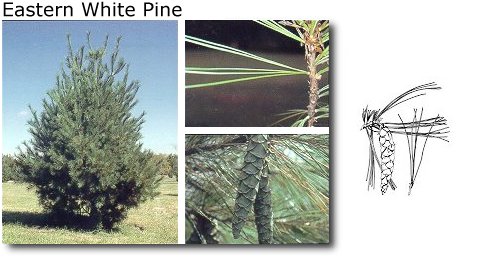
''Eastern White Pine''❖ About this Tree:Prefers sandy-loam soils; avoid clay-wet soilsGrows 60' - 100' tall, 50 to 80 feet wide Growth rate is 3' - 5' per year Hardiness: Zone 3 ❖ Identification Tips:Leaves: Needles in bundles of 5; 3" - 5" long; slender; flexibleFruit: Cones; 4" - 8" long; cylindrical; often curved Twig: Orange brown Bark: Dark grayish brown; deeply furrowed on older trees; 1" - 2" thick with ridges |
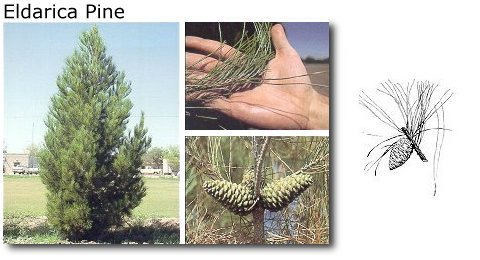
''Eldarica Pine''❖ About this Tree:Prefers fine sands, silt loams to silty clay loams, and very well drained to moderately well drained soilsFast growth if irrigated Hardiness: Zone 7 ❖ Identification Tips:Leaves: Needles 4" - 6" long borne in bundles of 2 or rarely 3; new growth blue-green, older growth darker greenFruit: Cones; reddish brown to brown; borne singly or in whorls of 3 to 6; cones are ovate-conic, approximately 4" in length; unarmed Bark: Silvery gray and shiny when young; becoming reddish brown; fissured and scaly on older trunks |
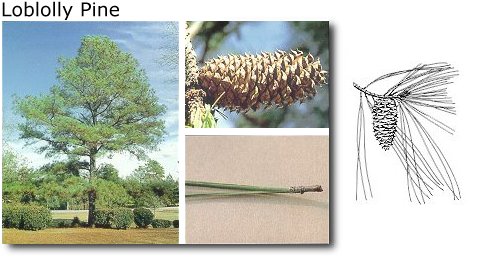
''Loblolly Pine''❖ About this Tree:Seeds eaten by Bobwhite quail and mourning doveTolerates poorly drained to well drained soils Grows 80' - 100' tall Hardiness: Zone 7 ❖ Identification Tips:Leaves: Needles; 5" - 9" long; 3 in bundle; stout, stiff, often twistedFruit: 3" - 5" long; conical Bark: Blackish-gray; thick, deeply furrowed into scaly ridges exposing brown inner layers |
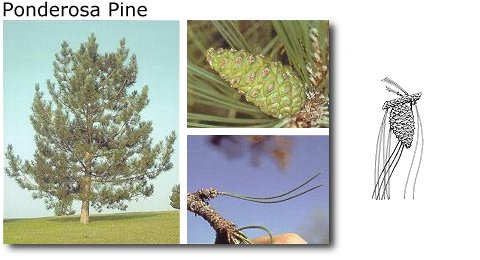
''Ponderosa Pine''❖ About this Tree:Seeds eaten by birds, mammalsCan grow on dry soils Grows 75' - 100' tall Hardiness: Zone 3 ❖ Identification Tips:Leaves: Needles; stout; flexible; yellow-green; 5" - 10" long; clusters of 2 or 3Fruit: Cone, tan-brown; 3" - 6" long; scales with prickles Twig: Stout; orange-brown; turpentine odor when broken Bark: Black, yellow-orange (old); wide, shallow-furrowed; flaky plates |
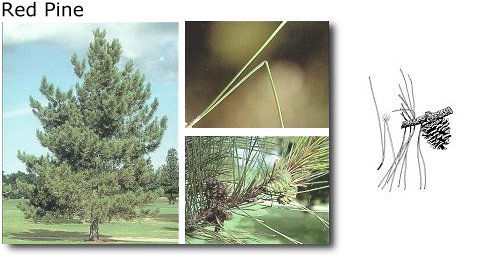
''Red Pine''❖ About this Tree:Seeds used by songbirds and small mammalsPrefers well-drained, sandy soils Grows 70' - 80' tall Hardiness: Zone 2 ❖ Identification Tips:Leaves: Needles; to 6½" long; 2 in a bundle; dark green, snap cleanlyFruit: Egg-shaped cones, 1½" to 2¼" long Bark: Reddish-brown or gray; with broad, flat, scaly plates; becoming thick |
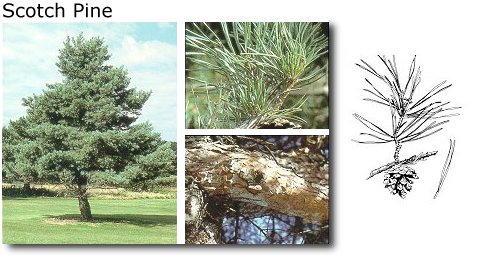
''Scotch Pine''❖ About this Tree:Prefers sandy to loam soilsGrows 50' - 75' tall Hardiness: Zone 2 ❖ Identification Tips:Leaves: Needles; 1½" - 2¾" long; 2 in bundle; stiff; slightly flattened; twisted; blue-greenFruit: Cone; 1¼" - 2 ½" long; egg-shaped; pale yellow-brown Bark: Reddish-brown; thin; becoming gray and shredding in papery plates |
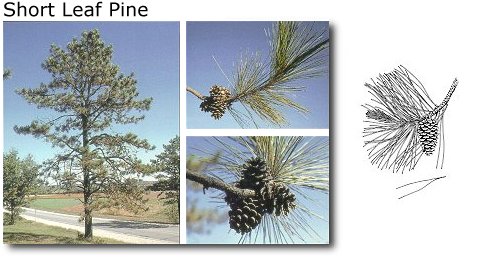
''Short Leaf Pine''❖ About this Tree:Seeds are eaten by mourning dove and Bobwhite quailPrefers dry ridges, sandy loams and silt loams Grows 30' - 70' tall Hardiness: Zone 6 ❖ Identification Tips:Leaves: Needles; 4½" long; 2 or sometimes 3 in bundle; slender, flexible; dark blue-greenFruit: 1½" - 2½" inches long; conical Bark: Reddish-brown; large scaly plates |
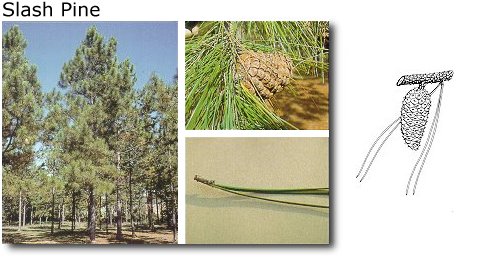
''Slash Pine''❖ About this Tree:Seeds eaten by Bobwhite quail and mourning dovePrefers poorly drained sandy soils Grows 60' - 100' tall Hardiness: Zone 7 ❖ Identification Tips:Leaves: Needles; 7" - 10" long; 2 and 3 in bundle; stout; stiff; shiny greenFruit: 2½" - 6" long; narrowly shaped; shiny dark brown Bark: Purplish-brown; flattened, scaly plates; rough and furrowed |
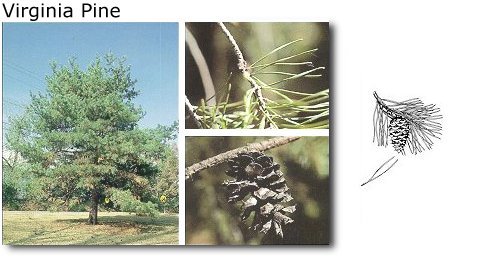
''Virginia Pine''❖ About this Tree:Good wildlife valuePrefers well drained soils Poor shade tolerance Good drought tolerance Grows 30' - 40' tall Hardiness: Zone 4 ❖ Identification Tips:Leaves: Needles, 1½" - 3" long; stout; gray-green; in bundles of two; twistedFruit: Dark reddish-brown; ovoid; lustrous; 1½" - 2½" long, with a sharp spine at the end of each scale Bark: Shallow fissures; dark brown loose scales |
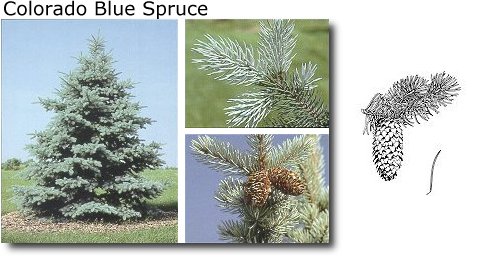
''Colorado Blue Spruce''❖ About this Tree:Winter cover for wildlifePrefers upland dry soils Grows 75' - 100' tall Hardiness: Zone 2 ❖ Identification Tips:Leaves: Needles; stiff; spirally arranged; 4-sided; ¾" - 1½" long; very prickly; sharp pointedFruit: Cone, oblong; tan-brown; cylindrical; 3" - 4" long; papery scales Twig: Stout; orange to gray-brown Bark: Silvery gray-brown |
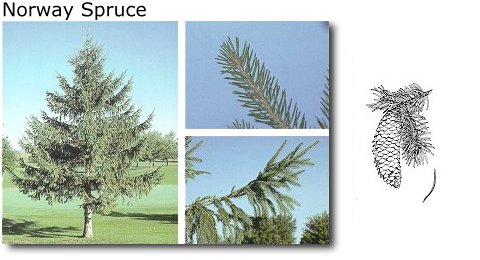
''Norway Spruce''❖ About this Tree:Foliage, twigs eaten by White-tailed deerNeedles eaten by grouse Winter cover for many species Prefers moist soil Grows 75' - 100' tall Hardiness: Zone 2 ❖ Identification Tips:Leaves: Needles; ½" to 1" long; stiff; 4-angled; sharp-pointed; shiny, dark green with whitish lines; drooping foliageFruit: Cones; 4" - 6" long; cylindrical; light brown; hanging down Bark: Reddish-brown; scaly |
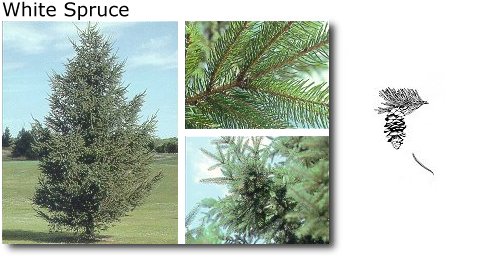
''White Spruce''❖ About this Tree:Foliage, twigs eaten by White-tailed deerNeedles eaten by grouse Winter cover for many species Prefers moist, sandy loam soils Grows 50' - 60' tall Grows 1' - 3' per year Hardiness: Zone 2 - 6 ❖ Identification Tips:Leaves: Needles ½" to ¾" long; stiff; 4-angled, sharp pointed; blue-green, with whitish linesFruit: Cones, 1" - 2" long Twig: Orange-brown; slender; peglike bases Bark: Gray or brown; inner bark whitish |
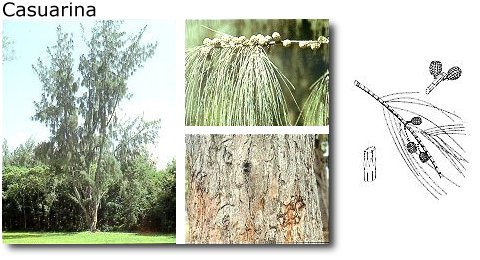
''Casuarina''❖ About this Tree:Provides perching and nesting for birdsTolerates dry or wet soil, salinity, heat and wind Grows 50' - 100' tall Grows up to 8' - 10' per year Hardiness: Zone 8 ❖ Identification Tips:Leaves: Scale-like; ⅛" longFruit: Light brown, warty ball Bark: Light gray brown; smoothish on small trees, later becoming furrowed |
|
|
| Copyright © 2025 ~ Arizona Lumber-4-Sale ~ A division of Arizona Specialty Woodcrafts |